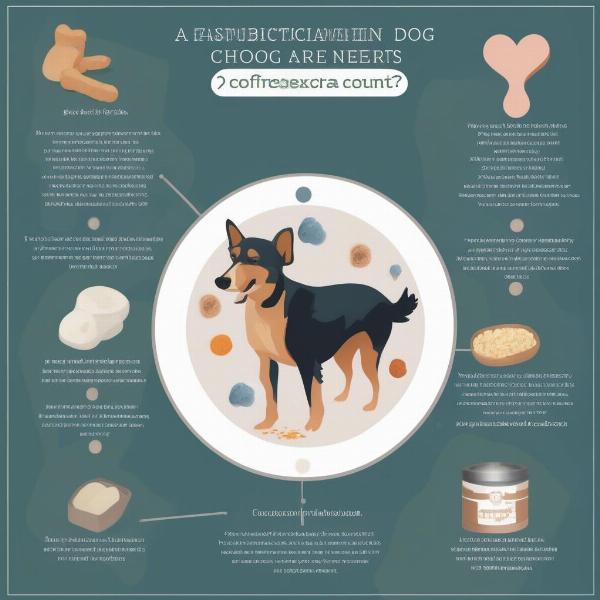Probiotic dog treats are increasingly popular among pet owners seeking to boost their furry friends’ digestive health. But what exactly are they, and how can you choose the right one for your dog? This comprehensive guide explores the world of probiotic dog treats, covering everything from their benefits to potential side effects, helping you make an informed decision for your canine companion.
Understanding Probiotic Dog Treats: What Are They and Why Use Them?
Probiotics are live microorganisms, primarily bacteria and yeasts, that, when administered in adequate amounts, confer a health benefit on the host. In dogs, these beneficial bacteria can help maintain a healthy balance of gut flora, crucial for optimal digestion and overall well-being. Probiotic dog treats offer a palatable way to deliver these beneficial bacteria directly to your dog’s digestive system. They can be particularly helpful for dogs experiencing digestive issues like diarrhea, gas, or constipation. They may also support immune function and overall health.
Choosing the Right Probiotic Dog Treat: A Comprehensive Guide
Selecting the best probiotic dog treat can feel overwhelming with so many options available. Look for treats containing specific strains of probiotics known to be beneficial for dogs, such as Lactobacillus and Bifidobacterium. Check the CFU (Colony Forming Units) count, which indicates the number of live bacteria in each treat. Higher CFUs generally mean a more potent product. Consider your dog’s age, size, breed, and any specific health concerns. Always consult with your veterinarian before introducing new supplements to your dog’s diet, especially if they have pre-existing health conditions.
 Choosing the Right Probiotic Dog Treat
Choosing the Right Probiotic Dog Treat
Potential Side Effects and Precautions
While probiotic dog treats are generally safe, some dogs may experience mild side effects like gas or loose stools, especially when first introduced. Start with a small amount and gradually increase the dosage as your dog adjusts. If your dog experiences any adverse reactions, discontinue use and consult your veterinarian. Store probiotic treats according to the manufacturer’s instructions, as exposure to heat or moisture can reduce their effectiveness.
Incorporating Probiotic Dog Treats into Your Dog’s Diet
Probiotic dog treats can be given as a supplement to your dog’s regular diet. Follow the recommended dosage on the product label or as advised by your veterinarian. You can offer them as a training reward, a special treat, or simply add them to their meal. Remember that consistency is key when it comes to seeing the benefits of probiotics.
Are Probiotic Treats Right for Your Dog?
Dr. Emily Carter, DVM, a veterinary nutritionist, suggests, “Probiotic treats can be a valuable addition to a dog’s diet, especially for those with sensitive stomachs or recovering from illness. However, it’s essential to choose a high-quality product and monitor your dog for any reactions.”
Dr. Mark Johnson, PhD in Animal Science, adds, “The efficacy of probiotic treats depends on the viability of the bacteria. Proper storage is crucial to ensure the probiotics remain active and beneficial.”
Conclusion
Probiotic dog treats can be a beneficial supplement for supporting your dog’s digestive health and overall well-being. By understanding how probiotics work and choosing the right product, you can help your furry friend enjoy a happier and healthier life. Remember to consult your veterinarian before starting your dog on any new supplement.
FAQ
- What are the benefits of probiotic dog treats? Probiotic treats can aid digestion, reduce gas and bloating, boost the immune system, and improve overall gut health.
- How do I choose the right probiotic dog treat? Look for a product with high CFUs, dog-specific probiotic strains, and ingredients suitable for your dog’s needs.
- Can probiotic treats cause side effects? Some dogs may experience mild gas or loose stools initially, but serious side effects are rare.
- How often should I give my dog probiotic treats? Follow the product label instructions or your veterinarian’s recommendation.
- Where should I store probiotic treats? Store them in a cool, dry place as directed on the product packaging.
- Are all probiotic treats the same? No, different treats contain different strains and CFU counts, impacting their effectiveness.
- Can I give probiotic treats to puppies? Consult your veterinarian before giving any supplements to puppies.
Related Articles
ILM Dog is a leading online resource dedicated to providing dog owners with expert advice on all aspects of canine care, from breed selection and health to training and nutrition. We offer valuable insights into dog breeds, health and wellness, training tips, nutritional guidance, grooming advice, and recommendations for the best products and accessories. Depending on the context of the article, ILM Dog highlights relevant expertise in core areas such as Breed Selection, Health and Medical Care, Training and Behavior, Nutrition and Feeding, Grooming and Hygiene, and Products and Accessories. Contact us for personalized support at [email protected] or call us at +44 20-3965-8624. Visit ILM Dog for more information.